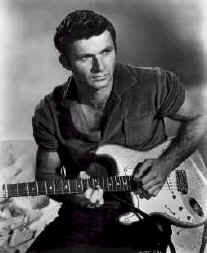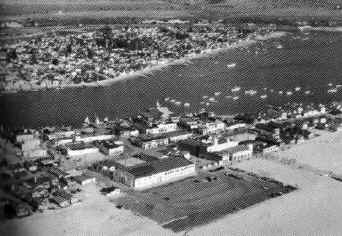
Surf Music
"Dennis Wilson was the only Beach Boy that
surfed. This is the music he listened to after a long day of
Surfing."
Jim Pash, The Surfaris, 1991
A Southern Californian genre of the early Sixties, surf rock celebrated not just catching the perfect wave, but such carefree adolescent phenomena as the sun, beach, parties, girls and hot rods.
Surfing the sport of Hawaiian kings was introduced to California at the turn of the century. In 1959, the sport received a boost from the movie Gidget, a tale of a young girl who spends a summer on the beach and falls in love with two surfers.
The innovations of two surfboard companies, Hobie Surfboards in Dana Point, and Sweet's Surfboards in Santa Monica, further popularized the sport. Hobie Alter and Dave and Roger Sweet replaced the heavy wooden board with a lightweight polyurethane foam strip coated with fiberglass and glossed with a polyester resin that could be handled more easily, an important consideration in the teen market.
Almost immediately, young people in Southern California started to buy the plastic boards and take to the waves. Surfing soon became an established craze in Southern California.
Surf music emerged in the late 1950s as instrumental rock and roll music, almost always in straight 4/4 time, with a medium to fast tempo. The sound was dominated by electric guitars, which were particularly characterized by the extensive use of the "wet" spring reverb that was incorporated into Fender amplifiers from 1963, and was meant to emulate the sound of waves. The outboard separate Fender Reverb Unit that was developed by Fender in 1961 (as opposed to reverb that was incorporated as a built-in amp feature) was the actual first "wet" surf reverb tone. This unit is the reverb effect heard on Dick Dale records, and others such as "Pipeline" by the Chantays and "Point Panic" by the Surfaris.
Guitarists also made use of the vibrato arm on their guitars to bend the pitch of notes downward, electronic tremolo effects and rapid (alternating) tremolo picking. Guitar models favored included those made by Fender (particularly the Jazzmaster, Jaguar and Stratocaster), Mosrite, Teisco, or Danelectro, usually with single coil pickups Surf music was one of the first genres to universally adopt the electric bass, particularly the Fender Precision Bass. Classic surf drum kits tended to be Rogers, Ludwig, Gretsch or Slingerland. Some popular songs also incorporated a tenor or baritone saxophone, as on the Lively Ones' "Surf Rider" and the Revels' "Comanche".

Surf music is a genre of rock music associated with surf Surf culture, particularly as found in Southern California. It was especially popular from 1958 to 1964 in two major forms. The first is instrumental surf, distinguished by reverb-heavy electric guitars played to evoke the sound of crashing waves, largely pioneered by Dick Dale and the Del-Tones. The second is vocal surf, which took elements of the original surf sound and added vocal harmonies, a movement led by the Beach Boy

Dick Dale and the Del-Tones
Surf music is a genre of rock music associated with surf culture, particularly as found in Southern California. It was especially popular from 1958 to 1964 in two major forms. The first is instrumental surf, distinguished by reverb-heavy electric guitars played to evoke the sound of crashing waves, largely pioneered by Dick Dale and the Del-Tones. Dick Dale developed the surf sound from instrumental rock, where he added Middle Eastern and Mexican influences, a spring reverb, and rapid alternate picking characteristics. His regional hit "Let's Go Trippin'", in 1961, launched the surf music craze, inspiring many others to take up the approach.
The second is vocal surf, which took elements of the original surf sound and added vocal harmonies, a movement led by the Beach Boys. Dick Dale "They were surfing sounds [with] surfing lyrics. In other words, the music wasn't surfing music. The words made them surfing songs. ... That was the difference ... the real surfing music is instrumental."
|
|
The new legion of predominately male teenaged surfers began to develop their own culture, dressing and speaking in a distinctive way. At high school the bleached-blonde surfers wore Pendleton shirts; sandals; white, tight, and somewhat short Levi's; and baggies - very large, loose, boxer-style shorts. After school they jumped into oversized station wagons with wooden sides (woodies), which transported their polys (surfboards), drove to the beach and dashed to the ocean. They ran with their sticks (surfboards) into the soup (foaming water near the beach) and tried to catch a wave. Some would only "fun surf" on the three-to-six foot waves. The more daring surfers would carry their "big guns" (surfboards designed for riding tall waves) into the water, pick up a "hairy" wave (a fast wave that is difficult to surf) and "shoot" (ride) it, sometimes "hot dogging" (performing tricks) to impress the "bunnies" (girls) on the shore. All surfers showed disdain for the poorly skilled or fraudulent, to whom they referred as "gremlins" or "kooks."

Dick Dale
Surfers listened to their own music that originated with Dick Dale and his Del-Tones. Born in Beirut, Lebanon, Dale (Richard Monsour) grew up on the Southern California coast and joined the hordes of young surfers. A guitar enthusiasts, Dale had released a few in distinctive singles on his own label in 1960. Dale worked closely with Leo Fender, the manufacturer of the first mass produced, solid body electric guitar and the president of Fender Instruments, to improve the Showman amplifier and to develop the reverberation unit that would give surf music its distinctively fuzzy sound.

Rendezvous Ballroom
During the summer of 1961, Dale and his band
unveiled the new surf sound during weekend dances at the
Rendezvous Ballroom in Balboa, California
Dick Dale and the Del-Tones released records for the surf crowd.
In September, 1961, "Lets Go Trippin'" topped the
California charts and edged toward the national Top Fifty. Dale
followed with "Surfbeat," "Surfing Drums,"
and "Shake 'n' Stomp," and in 1962 produced the
classical surf instrumental, "Miserlou." In early 1963,
Capitol Records signed Dale and called him the King of the Surf
Guitar. The same year he appeared in William Asher direct movie
Beach Party, and by 1963 had become a California celebrity.
By the end of 1963, surf music had become a national craze.
![]()